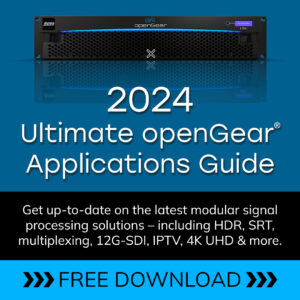Bryce Button talked with Matt Robbins and Simon Tillyer of KitPlus TV about how openGear frames are a flexible, powerful, and secure AV solution used in diverse environments like concerts, cruise ships, and churches. See all of AJA’s solutions at www.aja.com.
Matt:
Hello, and welcome to the show supported by MediaProxy. Today we’re continuing our series of openGear discussions. We’re delighted to welcome back to KitPlus TV, Bryce Button from AJA Video Systems. Hi, Bryce good to see you again.
Bryce:
Likewise, great to be here.
Simon:
So as Matt says, Bryce, we’re talking openGear. Give us a quick overview of what’s going on at AJA?
Bryce:
Well, openGear is a fantastic format. It’s basically the ability to mix and match all these wonderful cards with all these different capabilities and kind of tailor them to the project. So we found when we moved from original rack frames to openGear, the great advantage of course, is sharing a platform with many other vendors and the ability for the client to then mix and match what they really need from any particular vendor and utilize them in the same frame. And we made a concerted effort to basically take our most popular mini converters, originally starting with things like DAs and HDMI converters, which are always popular, whether it’s to or from SDI, and then bounce things up to 12G SDI, because we were trying to simplify 4K cabling as four times 3G SDI cables. This means four more areas where things could go a little wonky and then with the fiber stuff where you’re trying to extend everything, being able to get fiber converters in there that also handle a 12G SDI in some cases, really powerful stuff.
And they became a wonderful platform for us to move our Dante card to OG Dante 12G. And that has really blown up a whole area of markets that we were hoping we would be able to assist with, that have already taken to it. And that’s a lot of the AV market, for instance. I had some great interviews recently on a little podcast I’ve been doing and folks are putting them in all sorts of places from cruise ships to churches, to obviously we see them a lot on concert tours and some that are going on. We’ve got some coming up that are pretty interesting in the next few months. So they travel as well.
And then there’s a shared controller with the DashBoard software from Ross Video, which means that a user, once they get used to DashBoard, they’re pretty much in there. It also gives you the capability to mix with little things from other vendors like from automating the controllers , the ability to map your channeling, and that type of thing through their easy software.
So we continue to work away at it. We certainly have to have some more cards available later this year again, and we’ll continue to build out on the platform because users have just simply found it sort of rational, easy choice. You put the frame in place, go out for your project if it’s a flypack scenario, and you simply tailor and mix cards as you need to. So it’s about density. Getting as many converters that are then able to talk amongst each other. With a frame like that, you’ve got power supply redundancy. So it’s just a little bit more secure than a lot of other approaches.
Matt:
Very good. You mentioned Dante there and a lot of the other cards, one thing you didn’t mention, which you’ve recently really entered into, which I’m hoping I’m not going to break something here that you don’t want to say, but NDI, when are we going to see NDI on your openGear cards. Is that coming?
Bryce:
So that’s an interesting one. We’re obviously looking at it. We’ve taken the NDI stuff to a turnkey solution with Bridge Live. And for those not familiar with Bridge Live, it’s a powerful sort of encoding, decoding, transcoding box between 12G SDI and about codecs. And then as we’ve looked at the reality of the IP field for the best card to use, an uncompressed card, you’re obviously going to go to ST 2110, but it is a fairly expensive and hefty infrastructure investment. Whereas with NDI, you can utilize a lot of 1GB infrastructure, things like literally off your laptop, you can plug into and get into, even from your iPhone. There’s a lot of software ports to get into the ecosystem. And at this point there are literally thousands of NDI little devices out there from PTZ cameras, etc. So, yeah, we integrated with the Bridge Live first because of the amount of power that’s going on. You’ve got Nvidia RTX 4000 cards in there, we’ve got really great software from Comprimato, we’ve got AJA’s highly reliable 12G SDI and 3G SDI infrastructure in the same box.
And so the ability to transcode between all these things really does bridge you as you deal with the various environments that you run into. So the ability to take NDI and get it to H.265 and vice versa, pump it out 12G or 3G SDI into a router, we really think is going to be a great puzzle piece and move it around. So when it comes to something like you’re asking about the openGear platform, there are probably going to be different considerations that we need to consider if we decide to go down that path, but for the moment we think we’ve put it in just the right place in terms of the types mix of capabilities that folks are going to really need.
Simon:
We’ll put a link on screen (see video below) to a great conversation we had a little while ago that covered the whole of Bridge Live. And people can find out more about that. Just rewinding a little bit. The beauty of openGear is the control system. It’s going to be common across all of the openGear products you might have. And that’s one thing that people can really take advantage of.
Bryce:
Absolutely. If you go back a number of years, rack frame business was difficult for folks in the sense that they might have to go from project to project and learn completely different systems in terms of the control software, etc. And since these products tend to be used a lot in live environments, that’s asking a lot of the operator in terms of muscle memory, that type of thing. Nobody likes to be caught in a moment of panic going, where do I find that, especially if it’s a live event with sports or music or anything like that. You don’t get a second chance. The Rolling Stones aren’t going to come back on stage for you because you happen to miss the main choice. So that kind of like simplifying things has been really key. And it’s also been a very nice, sleek, sophisticated interface.
It can be as simple as it needs to be with the simpler converters with kind of set-it-and-forget-it stuff. And then with other items where we have like Roy HDMI stuff going on and you actually want a bit find of control, it’s being relatively, we always use these terms carefully otherwise engineers take my head off, but relatively simple to code for. And I think that has benefited everyone. And when you do add very specific things to your own product, you’re still putting your own firmware, each vendor of course could put their own firmware on the actual hardware. But again, it’s that simplifying the GUI engagement, right? That interface and making it as low as we can by adhering to some basic structures that is going to be common to all of us vendors that are producing for the platform.
Simon:
Is there actually also another app as well, Bryce, that say an AJA out that actually helps you choose which AJA card is going to be the right fit depending on what you’re looking to convert?
Bryce:
Yeah. So what you’d want to do there, is we’ve got a little app called AJA Mini-Matrix. And when you’re looking for products, we have a category for openGear. And the great thing is you can type in basic search terms and so on. So if you’re sitting there in a flurry, you put this package together. You’ve got a cruise ship that’s got to go out and you can do things like type in, okay, I need to go from SDI to HDMI over here, and I’m also looking for some fiber connectivity, and this little app you can download off iTunes.
If you’re on Android, just look at it from a webpage, it’s actually formatted to serve a JSON file to you. So it’s always up to date. We updated it yesterday, in fact, as a mini converter had expired. So we needed to pull them out of the list. So it’s always current and it’ll universally search and that’ll just make it really fast for you to figure out: Oh, okay, this is the problem I have, here is what AJA is suggesting in terms of potential solutions. I can simply go on and immediately know the name, and I can rent or order this particular card to deal with this project.
Matt:
Fantastic. Well, we spoke about openGear with you before, and we I’m sure we’ll be speaking to you again about it. There’ll be new releases. We look forward to more, thanks for coming on Bryce, and check out all the AJA solutions at aja.com. And of course the app to find out which card suits your problem. Don’t forget, this is one of a lineup of openGear interviews, so watch out for the rest coming soon from a number of key partners.
See all of AJA’s solutions at www.aja.com.

